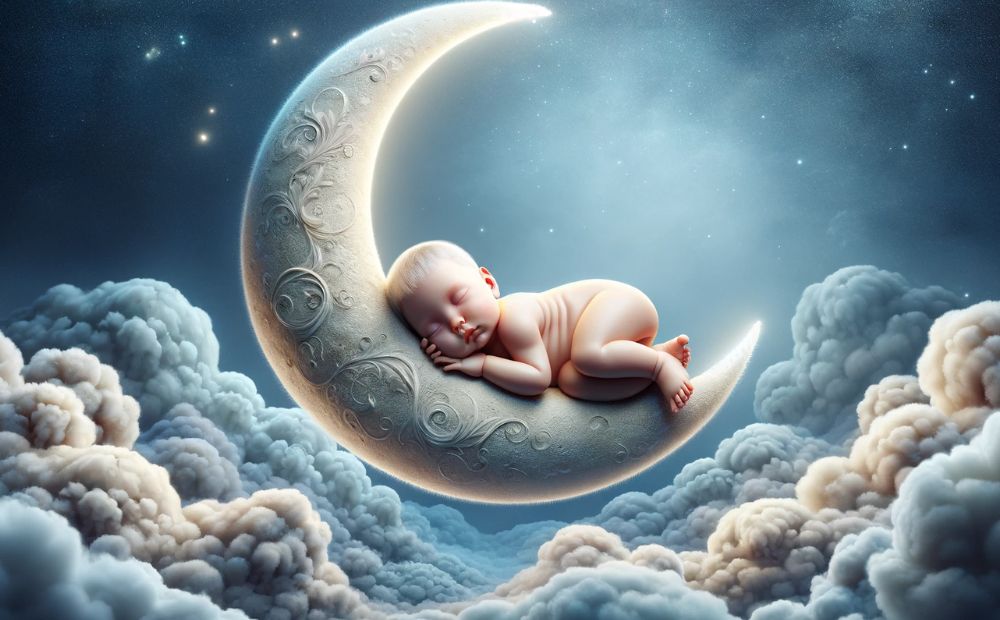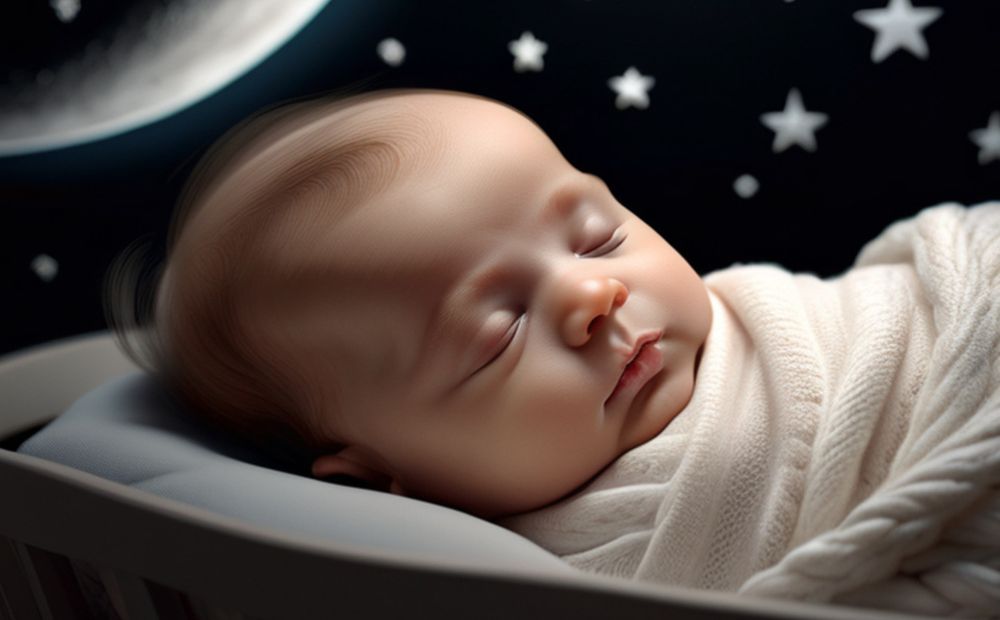The challenge of ensuring adequate sleep for newborns and infants is a common struggle faced by many parents. In the initial months of life, babies often have irregular sleep patterns, which can result in sleep deprivation not only for the child but also for the caregivers. It is well-documented that sleep plays a crucial role in a baby’s development, contributing to physical growth, cognitive development, and emotional well-being. However, many parents find themselves grappling with various sleep-related issues, such as difficulty in establishing a sleep routine, frequent awakenings, and the inability to soothe a fussy baby.
Statistics indicate that a significant number of parents report sleep deprivation within the first year following the birth of their child. According to research, approximately 30% of new parents experience moderate to severe sleep disruption. This lack of sleep can lead to various consequences, including increased stress levels, deteriorating mood, and heightened incidence of postpartum depression. Recognizing the importance of sleep for both babies and parents is imperative. Parents who are well-rested are better equipped to care for their newborns, leading to a healthier parent-child dynamic.
Moreover, there are several sleep challenges specific to infants, such as the startle reflex and transitioning between sleep cycles. These challenges often leave parents feeling overwhelmed and desperate to find effective solutions. As the journey of parenthood unfolds, many seek resources and strategies to navigate these hurdles, aiming for a calmer and more restful sleep experience for themselves and their babies. As we explore potential solutions, one avenue worth considering is the use of white noise, which has garnered attention for its soothing effects and potential to help create an environment conducive to baby sleep.
Understanding White Noise

White noise refers to a consistent sound that covers a wide range of frequencies, creating a soothing auditory backdrop. The science behind white noise lies in its ability to mask other sounds, thereby promoting a calmer environment. This phenomenon occurs due to the way the human brain processes sound frequencies. When a continuous sound is present, it can help to drown out sudden noises that might startle a sleeping baby, allowing for longer and more restful periods of baby sleep.
In essence, white noise acts as a gentle acoustic barrier, creating a sound environment that can be particularly beneficial for infants. Babies are often accustomed to the muffled sounds of the womb, making white noise a familiar and comforting experience. Studies have indicated that consistent sound exposure can promote relaxation in infants, as it mimics the soothing sounds they experienced pre-birth. This calming effect is crucial for infants who may struggle to settle down in quiet or disruptive environments.
Various types of white noise generators are available to assist caregivers in creating an optimal sleep environment for their babies. These include dedicated white noise machines that produce a steady sound and smartphone applications that offer a variety of white noise options. Some apps even allow users to customize the sound by adjusting volume and choosing from multiple sound profiles, such as ocean waves or rainfall. Selecting the right white noise generator can significantly impact a baby’s sleep, as it is essential to find a sound that not only conceals disruptive noises but also soothes the infant.
Ultimately, understanding the role of white noise can help parents and caregivers create a more serene sleep setting for their babies, enhancing their overall sleep quality and promoting healthy sleep habits.
The Benefits of White Noise for Babies
White noise has gained recognition for its numerous benefits in promoting baby sleep. One of the primary advantages is its ability to effectively mask disruptive noises, such as household sounds or outdoor disturbances. As babies are often easily startled by sudden noises, the consistent sound of white noise creates a soothing backdrop that can help them remain undisturbed during sleep. By minimizing interruptions, white noise allows for longer periods of uninterrupted slumber, which is essential for healthy growth and development.
Furthermore, white noise fosters a calming environment that is conducive to sleep. For newborns, who are transitioning from the confines of the womb to the outside world, white noise can serve as a comforting auditory cue. The familiar sound mimics the consistent whooshing noises they experienced in utero, which can help ease the transition into the new environment. This sense of familiarity can be instrumental in establishing a sense of security and comfort, promoting better sleep quality for babies.
Another beneficial aspect of incorporating white noise into a baby’s sleep routine is its role in establishing a consistent sleep pattern. By using white noise as part of the bedtime ritual, parents can signal to their infants that it is time to wind down and prepare for sleep. The association between the sound of white noise and the sleep process can help form a routine that baby learns to recognize. Over time, this can lead to healthier sleep habits, making it easier for babies to fall asleep and stay asleep independently.
Ultimately, white noise offers a simple yet effective method for enhancing baby sleep by masking disturbances, creating a tranquil atmosphere, and establishing reliable sleep routines. Its ability to mimic the womb environment further solidifies its importance in providing comfort to infants.
How to Use White Noise Effectively

Implementing white noise into a baby’s sleep routine can significantly enhance their quality of sleep. Firstly, it is essential to consider the volume level when using white noise. Experts recommend keeping the sound at a safe distance from the baby’s ears; a volume of around 50-60 decibels is generally considered appropriate. This volume mimics the sounds womb-related noise, offering familiarity and comfort while ensuring the baby’s safety.
There are various devices and methods available for creating white noise. Many parents opt to use sound machines specifically designed for babies, which often include a range of soothing sounds—like ocean waves, rain, or traditional white noise. Additionally, smartphone apps can be valuable alternatives, allowing parents to customize sounds easily. Whichever method is chosen, it is vital to ensure that the sound is continuous and not overly disruptive, as intermittent sounds may startle a baby awake rather than providing a calming effect.
Timing is another critical factor in utilizing white noise effectively. It is advisable to introduce white noise during the baby’s sleep routine, starting just before the baby falls asleep until they have settled into a deeper sleep phase. This timing helps create a strong association between the sound and sleep, enhancing the effectiveness of white noise. As babies grow, gradual transition away from white noise may be beneficial. Slowly reducing the sound over time can help ease the baby into quieter environments, preparing them for natural sleep conditions as they evolve.
Incorporating these practical tips into a baby’s sleep routine can significantly improve their sleep experiences. The use of white noise, when implemented correctly, can provide a soothing backdrop that promotes restful sleep, fostering healthier sleep habits essential for a baby’s growth and development.
Different Types of White Noise Machines
When it comes to enhancing baby sleep, white noise machines have gained significant popularity among parents seeking to soothe their infants. Numerous options are available, ranging from standalone devices to smartphone applications, each catering to different preferences and budgets. Understanding the various types of white noise machines can help parents make informed choices when selecting the right product for their baby.
One of the most common types is the portable sound machine. These compact devices are designed for easy transportation, making them ideal for use both at home and on the go. Many portable machines offer various sound settings, including traditional white noise, rain sounds, or lullabies. Prices for these devices typically range from $20 to $60, depending on the brand and features. Parents often appreciate their simplicity and reliability, especially during travel or when visiting family.
Another option worth exploring is smartphone applications that generate white noise. These apps often provide a wider array of sound choices and customizable features, such as timers and adjustable volumes. Many applications are available for free or at a minimal cost, offering parents a budget-friendly alternative. However, it’s essential to ensure that the device’s battery lasts long enough to support uninterrupted baby sleep throughout the night, as this may affect usability during extended use.
Lastly, some devices combine white noise with additional sleep-enhancing features, such as night lights or smart home integration. These versatile machines might have a higher price point, often ranging between $50 and $100, but they can offer greater convenience and functionality for parents. User reviews frequently highlight their effectiveness in creating a tranquil sleep environment for babies.
In conclusion, selecting the right white noise machine for enhancing baby sleep requires careful consideration of the available options. By comparing features, prices, and user experiences, parents can find a device that best suits their needs and preferences.
Potential Drawbacks to Consider

While the use of white noise can offer numerous benefits for enhancing baby sleep, it is crucial to be aware of the potential drawbacks associated with this practice. One significant concern is the possibility of a baby developing a dependency on white noise for sleep. If a baby becomes reliant on these soothing sounds, they may struggle to fall asleep in environments where the noise is absent, leading to difficulties during travel or in public settings. This dependency can hinder the development of self-soothing skills, which are important for long-term sleep health.
Another important aspect to consider is the potential negative impact on a baby’s hearing if white noise is not used correctly. According to experts, exposure to loud sounds can be damaging to a baby’s sensitive ears. The recommended volume for white noise devices should be no louder than the sound of a running shower. Parents should be cautious about placing these devices too close to the infant’s crib, as prolonged exposure to loud sounds can pose risks to hearing development, countering the benefits of improved sleep.
Moreover, it is essential to differentiate between gentle background noise and louder, harsher sounds. While gentle, consistent sounds can promote a calming environment conducive to sleep, excessively loud or jarring noises may have the opposite effect. This discrepancy may create a less-than-ideal sleeping atmosphere, potentially leading to increased anxiety or restlessness in sensitive babies. Thus, while white noise can be a powerful tool in promoting better baby sleep, it is important to use it responsibly and mindfully, ensuring that the volume levels and types of sounds are suitable for the infant’s well-being.
Alternatives to White Noise
While white noise is a popular choice for promoting baby sleep, it is essential for parents to explore various alternatives that may suit their child’s unique preferences. These soothing sounds can range from lullabies to nature sounds and gentle instrumental music, each offering distinct benefits that help create a calming sleep environment.
Lullabies have been a timeless method for assisting babies in falling asleep. The gentle melodies and soothing lyrics can create a nurturing atmosphere, making them an excellent alternative to white noise. Parents can either sing these lullabies or utilize recordings, catering to the baby’s auditory preferences. Furthermore, the rhythmic patterns typical of lullabies can signal to the baby that it is time to wind down, encouraging relaxation and sleep.
Another alternative lies in the use of nature sounds, such as rainfall, ocean waves, or forest ambiance. These sounds can evoke a sense of tranquility and mimic the natural world, providing comfort to babies who may be sensitive to their surroundings. Nature sounds are often less jarring than white noise and can be played softly in the background, creating a serene environment conducive to baby sleep.
Gentle instrumental music is also an effective choice. Soft piano melodies or light acoustic guitar tunes can help to soothe babies and facilitate restful sleep. Many parents find that instrumental music promotes a peaceful ambiance without the potential overstimulation sometimes caused by other sound types. Parents should consider experimenting with different genres and tempos to identify what resonates best with their baby.
In conclusion, while white noise is a widely accepted solution for promoting baby sleep, parents have numerous alternatives at their disposal. Lullabies, nature sounds, and gentle instrumental music offer unique auditory environments that can effectively aid in creating calmer sleeping conditions for babies. Exploring these options enables parents to discover the best fit for their child’s individual needs, ensuring a more restful sleep experience.
Expert Opinions and Research Findings

Numerous pediatricians and child psychologists have weighed in on the effectiveness of white noise in promoting baby sleep. According to Dr. Harvey Karp, a renowned pediatrician and author of “The Happiest Baby on the Block,” many infants respond positively to white noise due to its calming effects that mimic the sounds heard in the womb. This environment can help soothe babies and create a conducive atmosphere for sleep. Dr. Karp suggests that consistent exposure to white noise can signal to infants that it is time to sleep, which aids in transitioning them into a restful state.
Moreover, a study published in the journal “Pediatrics” observed that white noise helped over 80% of babies fall asleep within five minutes, compared to those who did not experience this auditory aid. The researchers highlighted that using white noise provided a soothing backdrop, allowing infants to drift into slumber more easily. Psychologists emphasize the importance of understanding the developmental needs of infants regarding sleep. Many experts advocate for the use of white noise as a sleep tool, especially in environments that may be prone to disturbances, such as those with loud household activities or siblings. However, some caution against prolonged exposure, recommending that the volume level be kept at a safe intensity to avoid potential hearing damage.
Furthermore, as white noise machines gain popularity, parents are encouraged to choose products specifically designed for infants. This ensures that the sound quality is appropriate, and the device adheres to safety standards. In essence, while the integration of white noise can foster better baby sleep habits, parents should remain vigilant about its use and prioritize their child’s overall auditory health.
Conclusion and Final Thoughts
In exploring the benefits of white noise for enhancing baby sleep, it becomes clear that this simple sound can offer substantial advantages. White noise provides a soothing auditory environment that can mask sudden disruptive noises, promoting deeper and longer sleep for many infants. Numerous parents have reported positive changes in their baby’s sleep patterns after integrating white noise into their bedtime routine, resulting in both peaceful nights for the child and much-needed rest for caretakers.
It is important to recognize, however, that each baby has unique preferences and sensitivities. While many infants respond favorably to white noise, it may not be suitable for every child. Factors such as temperament, preferred sound types, and volume should be considered when introducing this technique. Some babies may find white noise calming, while others might be more sensitive and prefer silence or ambient sounds like gentle music or nature sounds. Thus, a period of experimentation may be necessary to discover what resonates best with your little one.
To ensure a safe and effective use of white noise, parents should keep sound levels at a moderate volume and avoid placing the noise source too close to the crib. It is advised to begin with short sessions of white noise, gradually incorporating it into the sleep regimen as the baby becomes accustomed. Remember, the primary goal is to support your baby’s natural sleep patterns while fostering a comforting environment.
Ultimately, utilizing white noise can enhance your baby’s sleep experience and ease the transition into slumber. It is a valuable tool in a parent’s arsenal for cultivating restful sleep, but taking a personalized approach will ensure optimal results for your family’s needs. By being attentive to your baby’s responses, you can create a serene sleep environment that promotes the best sleep possible.
Explore different white noise options specially designed for best baby sleep here
YouTube – https://www.youtube.com/@BabysBedtimeMelodies-sleepwell



